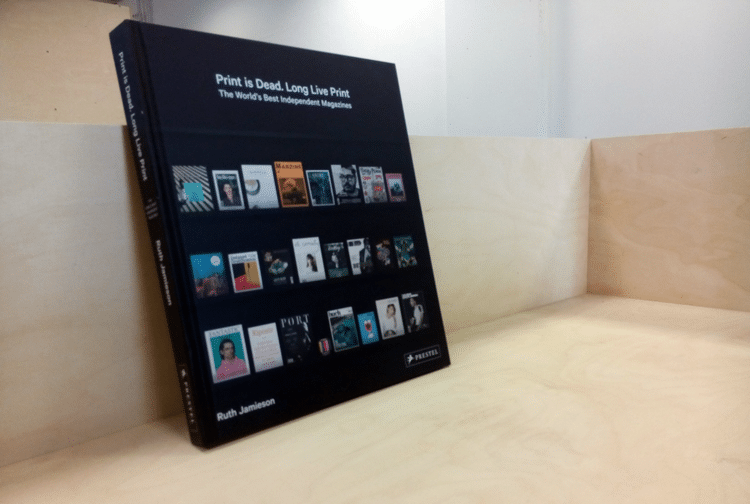Print is dead. Or is it?

Print is dead. Or, sort of, but not really. While former big time titles like Spin and The Face have vanished from newsstands, indie magazines are springing up left and right and centre.
In her book Print is Dead. Long Live Print, published last week by Prestel, Ruth Jamieson celebrates the indie mag boom by showcasing 53 publications including Delayed Gratification.
With heavy, black pages richly illustrated with example spreads, Print is Dead will be the envy of any coffee table. But the book is more than just a thing of beauty. To get to know the titles she wrote about, Jamieson spoke to more than 100 people in the industry (“And every single one made me want to stop what I was doing and start a magazine. It’s a miracle this book got written, it really is”). We asked her some questions about her research. Here’s what she said.
Why did this book come about now?
“The whole ‘Is print dead?’ question has been knocking around for a while now. Digital people say it is dead. Print people say it isn’t. I wanted to change the record and say, yes, a certain kind of print is dead, or dying, but who cares? Quite simply, the internet does fast, cheap distribution of throwaway information much, much better than print does. So in killing that specific kind of print, digital media has cleared the way for a new, much more interesting, much more exciting print to spring up. The reason for publishing the book now is to draw a line under the death of print debate and start to celebrate the birth of a new kind of print instead.”Where do you think the indie mag scene is headed in the next five years?
“It’s easier than ever before to start a magazine. But it’s still pretty challenging to keep one going past its first year. Even more so as more and more amazing magazines hit the stands. It’s an increasingly competitive market. So, I think we’ll see more magazines come and go. But the standard will continue to rise. There really hasn’t been a better time to be a magazine fan.A strong core idea is crucial. As is respect for your readers. But most of all, the ones that will do well are the ones that have an entrepreneurial spirit. Magazines like Works That Work aren’t just reinventing the design magazine genre but are also addressing the entire magazine publishing business model with exciting innovations like crowd distribution and reader funding. Likewise, publishers that view their magazine as just one aspect of their output will do well. Magazines like WRAP whose raison d’être is to share amazing illustration. One expression of that is publishing a magazine, another is a line of stationery products.
It’s also important to note that doing well doesn’t necessarily equate to publishing lots of issues or copies. It’s possible to succeed by really nailing a concept in a single issue. I’m very interested in A Mag For All Seasons which will only publish four issues, one for each season. And I love LAW which only prints 500 copies of each issue. Those 500 issues are incredibly desirable and highly sought after. That’s what doing well means for them.
Overall, it’s a cliché but the ones that do well will be the ones that zig when everyone else zags. Just as Delayed Gratification has done by bucking the trend for ever-faster reporting and focusing on slow journalism instead.
Look at what the independents and craft magazines are doing, and you will absolutely see where the mainstream is going. Some indies will join the mainstream sure, but we’ll also see mainstream magazines become more like the indies. They have to if they want to survive. There will be more investment in content and more focus on producing a quality product, more collectable issues, a move away from trying to do things the internet can do better and towards doing things only print can do. We’ll also see magazines branching out beyond their print issues to offer other things, like events, products, educational programmes and experiences.”
What was the most surprising thing you learned while researching Print is Dead?
“Aside from being constantly blown away by the creativity of the magazine makers I met, one of the most encouraging things I discovered was just how many women are involved in the rebirth of print. Women are in senior positions. They are creative directors, editors, art directors, publishers. At a time when we’re increasingly aware of the lack of female voices in the media and other positions of influence, I found this incredibly heartening. I hope it’s a sign of things to come. And I hope that the same will happen with other poorly represented groups.”
Slow Journalism in your inbox, plus infographics, offers and more: sign up for the free DG newsletter. Sign me up
Thanks for signing up.





